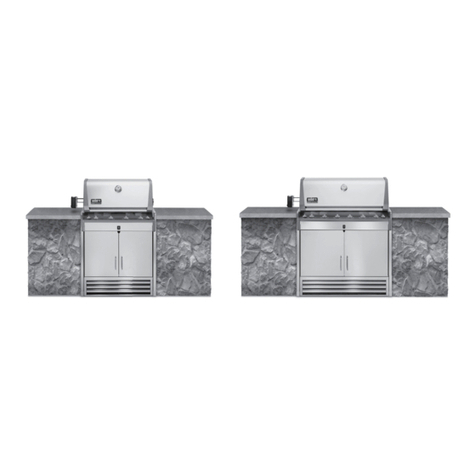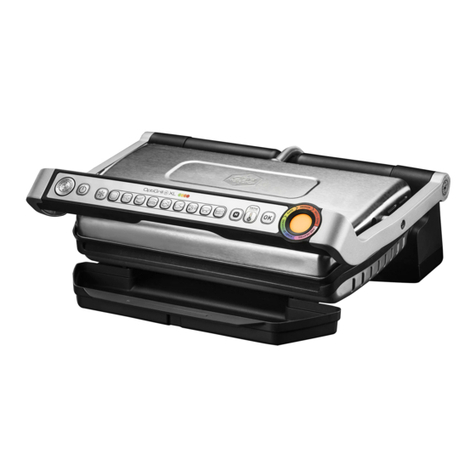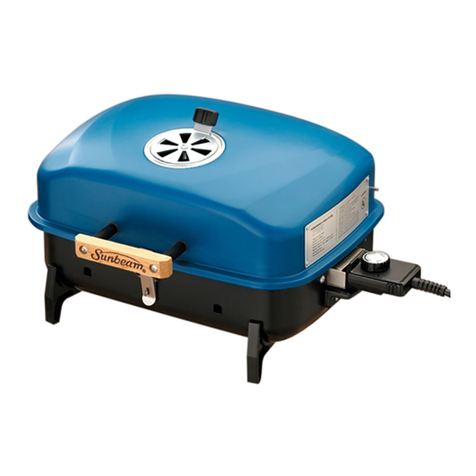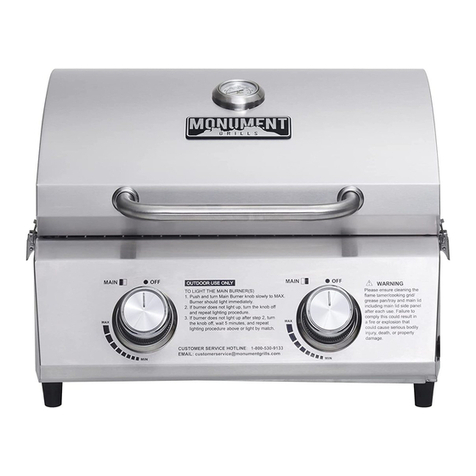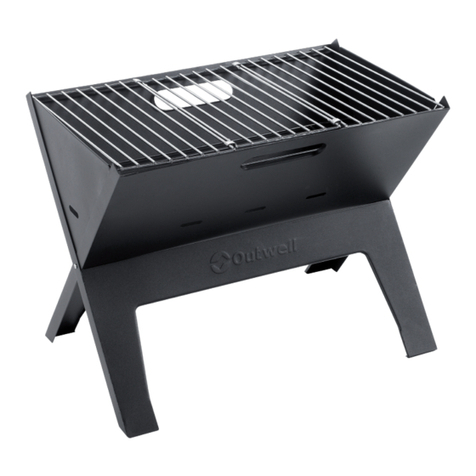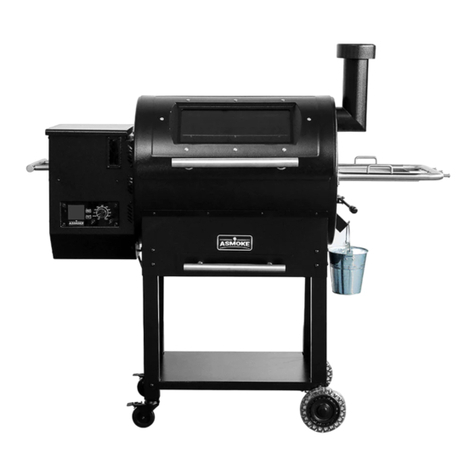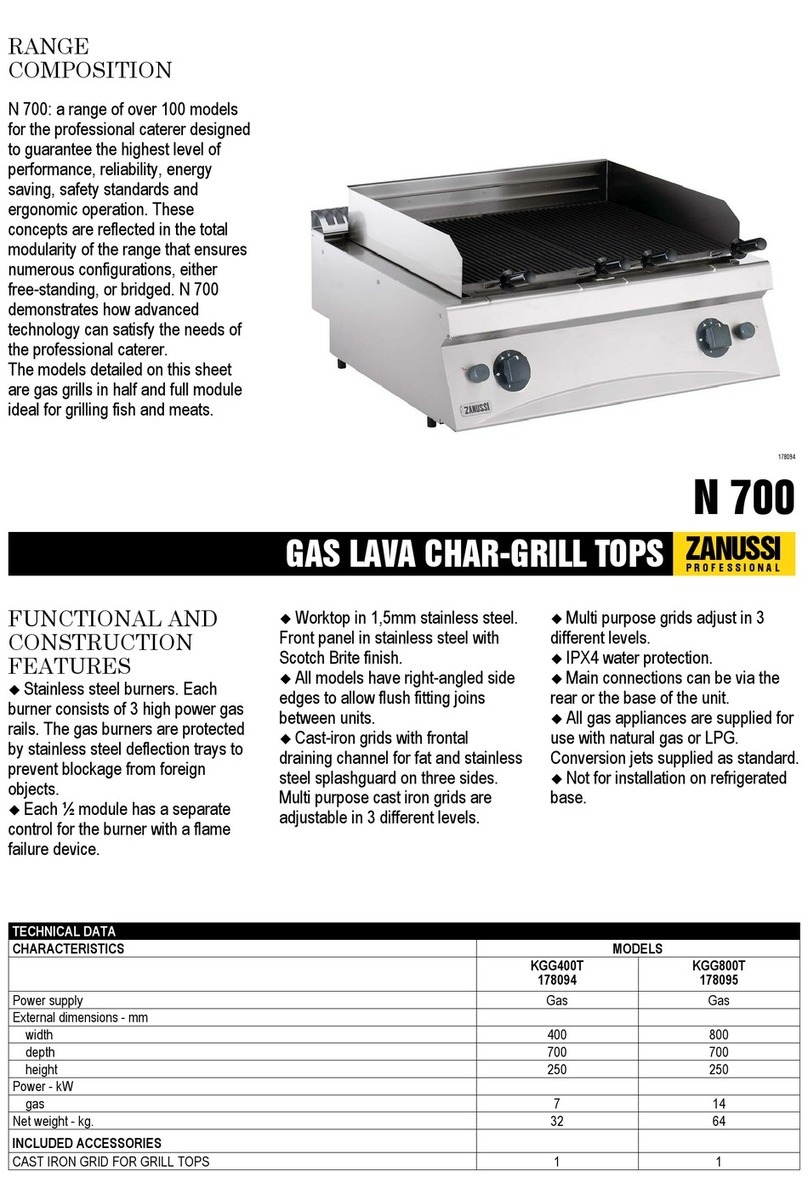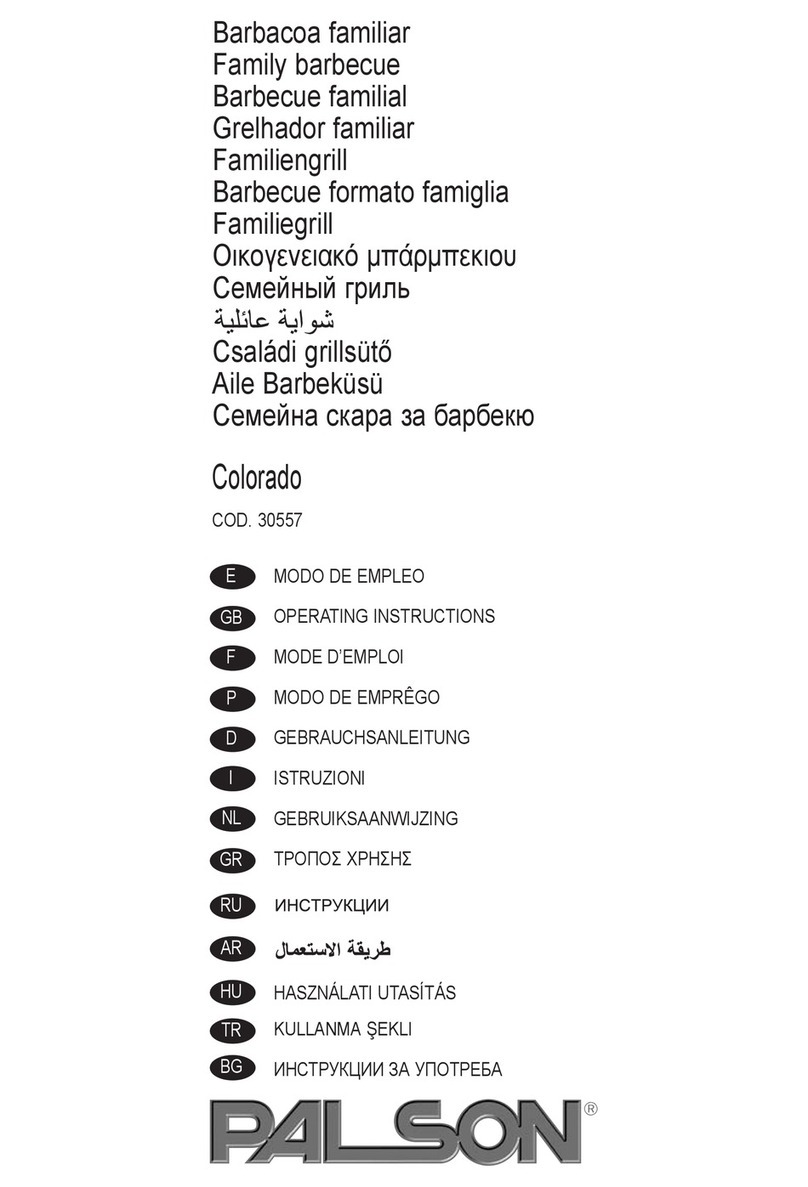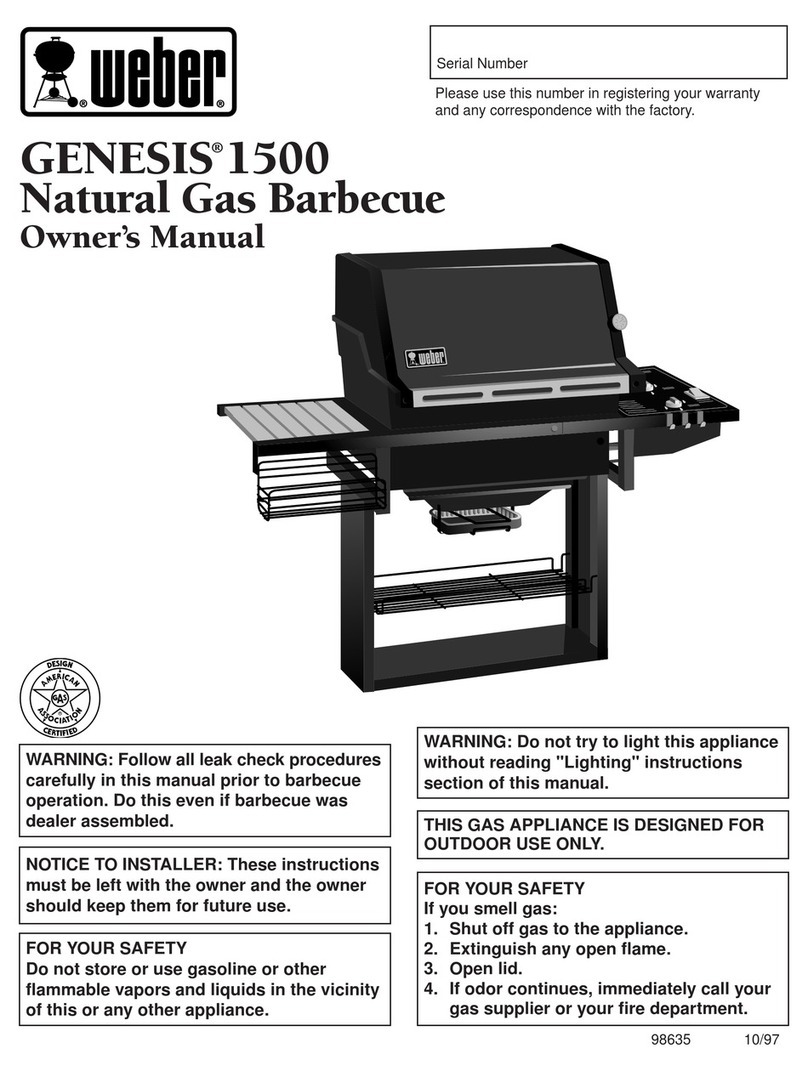GRILLWERK KENA User manual

MF 1
Instruction Manual

2 3
Congratulations on the purchase of your Kenia designed and
manufactured by Grillwerk! The Kenia should meet all your
barbecue expectations, give you a lot of pleasure and last a
lifetime. In order to achieve all this, please read this manual
carefully, even if the Kenia seems to be self-explanatory.
Content
Warnings 5
Unpacking and assembly 6
The Kenia and its functions
in detail 9
And finally –
the barbecue starts 11
How to proceed now 14
Maintenance 17
Dimensions & weights 19

4 5
First of all, you must be aware that the Kenia heats up to
much higher temperatures than conventional barbecue
devices because of the very efficient ventilation of the
charcoal grate! Therefore, use coal sparingly and fill
the charcoal grate only up to about 1/3 of its height.
When you put the hood on - which should be avoided
during the ignition process - you must always make sure
that the temperature does not exceed the maximum
range of the thermometer of 350° C. The hood can de-
form at higher temperatures and make it unusable. After
cooling deformations disappear and the original shape
is restored.
Please always follow the safety instructions
according to DIN EN 1860-1:
• The grill must be placed on a safe, level surface
before use.
• ATTENTION: This grill becomes very hot and
must not be moved during operation!
• Do not use in closed rooms! This grill may only
be used outdoors in well-ventilated places.
• Do not operate the grill in closed and/or
habitable rooms, e.g. buildings, tents, caravans,
mobile homes, boats. There is danger to life
due to carbon monoxide poisoning.
• ATTENTION! Do not use spirit or gasoline for
lighting or relighting! Only use ignition aids
according to EN 1860-3!
• ATTENTION! Keep children and pets away!
• Do not put food on the grill until the fuel (charcoal)
is covered with a layer of ashes!
• Do not move the grill until the fuel (charcoal)
has completely cooled down!
• Let the charcoal cool down for at least 12 hours
before disposing charcoal residuals and ashes.
1. Warnings

6 7
The Kenia is delivered in a wooden no-nail box on a
one-way pallet. Firstly, please check there is no visible
external transport damage. If so, please contact us
address and the serial number of the grill. The serial
number is also noted on the outside of the no-nail box.
Then remove the packaging and dispose it properly.
Your Kenia grill is basically completely assembled when
delivered. You only have to remove the entire transport
protection and mount the crank for hight adjustment.
The standard delivery includes
• one Kenia grill device, consisting of the
individual parts as illustrated on the explosion
photograph below,
• the tools for lifting the charcoal grate and
• a 3 mm hex-wrench for the installation of the crank.
A waterproof cover is available as accessory at www.
grillwerk.eu.
First mount the crank by pushing it onto the shaft of the
height adjustment and tighten the grub screw with the
hex-wrench supplied.
Then move the crown upwards by turning the crank
clockwise until it stops. Now remove the transport pro-
tection as follows:
Remove the duct tape that secures the ash drawer and
take out the ash drawer. Then loosen the fastenings of
the cooking grate and remove it.
Now lift out the charcoal grate with the tools provided.
To do this, you have to tilt it - seen from the front in front
of the grill - diagonally to the side and lift it out at the
top. The inclined position is important to get past the
support points of the cooking grate.
You can now remove the cardboards on which the
coal grate rests. Then lift up the ash hopper and again
remove the cardboard on which it rests.
Then replace the charcoal grate in the opposite way
and push the ash drawer back into the ash hopper.
Now the Kenia is ready for use. But before starting,
you should read on and familiarize yourself a little more
with the functions of the Kenia.
2. Unpacking and assembly

8 9
1.
4.
7.
5.
6.
3.
8.
2.
Except for the charcoal grate and a few individual
parts, the Kenia is made entirely of high-quality
stainless steel.
The chassis supports the ash hopper with ash drawer,
the charcoal and cooking grate. The crown with back
and height adjustment mechanics are mounted to it.
The ash hopper collects the ashes and transfers them
into the ash drawer. At the same time, the ash hopper
also serves as a diffuser that allows air oxygen to pass
through the charcoal grate at equal velocity in order
to flow evenly over and against the glow. This creates
a uniform temperature profile over the entire cooking
grate.
The pre-installed height adjustment mechanics is
based on the commonly known scissors principle.
It is self-locking, heat-resistant and infinitively variable.
After removal of the transport protection it becomes
obvious, all parts lie fixed on each other stabilized
only by gravity and can easily be removed when the
crown is cranked up.
The charcoal grate is made of carbon steel and not
stainless. Unlike stainless steel, certain carbon steel
alloys hardly expand under the influence of heat and
are therefore the more suitable material for the
charcoal grate.
The charcoal grate features wide slots which, in
combination with the ash hopper / diffuser, ensure
intensive but uniform ventilation of the charcoal from
below (no „hotspots“). It ensures the charcoal is getting
3. The Kenia and its functions in detail
1. Hood with handle, thermometer
and ventilation controller
2. Charcoal grate
3. Ash hopper/diffuser with ash
drawer
4. Chassis with finished height
adjustment including crown
5. Crown with back
6. Ash drawer
7. Cooking grate
8. Wooden ventilation slide

10 11
red-hot evenly and particularly quickly. Cooking tem-
peratures above 500°C can easily be generated but
should be avoided.
The cooking grate has two handles and raised corners
that make it easier to put the hood on. It also prevent
food to role off.
You can use the crank handle to move the crown and
the cooking grate continuously upwards by about 15
centimeters to set the temperature.
Setting the temperature also works for indirect grilling.
If you crank the cooking grate up, the temperature is
reduced by up to 80° Celsius.
You use the hood for indirect grilling and generally
also as weather protection for the grill. The hood has
a „double bottom“ in the upper part, which creates an
air cushion below the surface of the hood, limiting the
radiation and heat to the top. The clear height between
the grill grid and the underside of the hood is about
12 cm. This limits the thickness or height of the food
that is cooked during indirect grilling process.
Use the thermometer to measure the temperature
inside the hood when the hood is in place. Under
the thermometer there is an adjustable ventilation
opening with which you can vent the grill when the
hood is on.
The slider on the front of the Kenia is used to regulate
the air supply to the charcoal grill. The slider is made
of smoked oak and therefore a natural product. The
slider can expand in high humidity or when exposed
to rain. This can influence the movability. When the
slider has reached a residual moisture of around 12%
after drying, the phenomenon should disappear.
In rare cases, it may happen that the slider warps when
exposed to heat and then also cannot be moved as
desired. Please inform us in such a case and we will
send you a replacement part immediately.
The trolley has four lockable rollers. Please always
make sure that the castors are locked and set radial
towards the outside of the grill center for a safe stand.
No grilling without coal – Not all barbecue charcoal
is of the same kind. The use of high-quality charcoal
and charcoal briquettes contributes significantly to the
desired grilling result.
Charcoal
Barbecue charcoal with the best quality characteristics is
made from hardwood species such as beech and oak.
„Mixed woods“ burn less well and have a lower carbon
content. Charcoal made of softwood also causes unde-
sirable flying sparks, which are caused by the heating of
enclosed resin.
Charcoal is made of wood that is heated up in the
absence of air. Two different methods are common,
either traditional in the so-called charcoal kiln or in an
industrial oven. The industrial production is superior to the
traditional process in terms of results, but also for environ-
mental reasons. Because higher process temperatures
are achieved in the industrial process, more by-products
such as acids and tars are burned or extracted during
the carbonization process and the carbon content of the
end product charcoal is significantly higher. Finally, in the
kiln or traditional charcoal process, more by-products are
released into the environment.
From a chemical point of view, charcoal differs in the le-
vel of carbon content, residual moisture and ash content.
The higher the carbon content and the lower the residual
moisture, the faster the charcoal is getting red-hot and
burns at higher temperatures. However, these factors can
also lead to a shorter burning time and a faster (uncontrol-
4. And finally – the barbecue starts

12 13
led) drop in temperature. Both can influence the results as
one may lose control over the cooking process.
All in all the lower ash content (white residue) remains a
decisive advantage, which does not hinder the heat ra-
diation from the ember during direct grilling and ensures
that there is little ash residue overall.
In addition the grain size also plays a role. The smaller
the coal pieces are, the larger the specific (reaction) sur-
face area, which in turn means that more carbon reacts
with air at the same time and generates more heat. The
disadvantage is that during ignition, the supply of air that
drives the reaction is hindered by the denser bulk and
smaller pieces of coal burn off faster than larger ones.
Charcoal briquettes
Charcoal briquettes consist of charcoal dust which is
pressed into shape with binders and other substances.
In terms of carbon and ash content, charcoal briquettes
are inferior to „natural“ charcoal. However, charcoal
briquettes feature a longer burning time and temperatu-
re constancy.
DIN-EN 1860-2
In Germany, the minimum requirements for charcoal
and briquettes are standardized by the DIN-EN 1860-
2 standard as follows
Good quality charcoal clearly exceeds the requirements
of the DIN-EN 1860-2 standard and achieves carbon
contents of over 85% with an ash content of less than
2%. The same applies to good charcoal briquettes.
Burning time and heat
The burning time depends on the type and grain size
of the charcoal or briquettes used, the grill used and
the amount of air supplied to the charcoal grate. As
already noted, it is generally true that charcoal briquet-
tes burn slower than charcoal. Charcoal briquettes are
therefore more suitable for slower indirect grilling than
for fast direct grilling. Also mixtures of charcoal and
briquettes can be the means of choice.
As a guideline, good charcoal on the Kenia is glowing
through after about 15 minutes and after reduction of
the air supply remains ready for grilling for a good
hour, whereby the maximum temperature of 300-500°
C is only maintained for the first 30 minutes and then
Test criteria Requirements
Charcoal
Requirements
Charcoal briquettes
Carbon content > 75 % > 60 %
Ash content <8 % <18 %
Humidity <8 % <8 %
bulk density 130kg/m3 -
Grain size
between 0 und 150 mm
max. 10 % >80 mm
at least 80 % >20 mm
max. 7% 0 – 10 mm
max. 10% >20mm
higher than direct imports would suggest. The WWF‘s
2017 market analysis has confirmed this: 40 percent
of the charcoal tested came from tropical or subtropical
countries.
Grillwerk therefore recommends the use of charcoal
from verifiably sustainable production such as FSC and
PEFC certified products. The WWF charcoal market
analysis also offers insights to products that should not
be purchased.
Product recommendations
Grillwerk particularly recommends products from Profa-
gus (www.profagus.de) and Nero (www.nero-grillen.
de). Charcoal and briquettes from these manufacturers
exceed the requirements of the DIN standard, come
from sustainable production and are FSC or PEFC
certified.
1https://www.destatis.de/DE/PresseService/Presse/Pressemitteilungen/zdw/2018/PD18_12_p002.html.
2http://www.wwf.de/fileadmin/fm-wwf/Publikationen-PDF/WWF_Holzkohle_Marktanalyse_Deutschland_2017.pdf.
drops. For charcoal briquettes, these times should be
approximately doubled; in addition, the temperature
attainable with charcoal briquettes remains below the
temperature attainable with charcoal.
Environmental protection
Grillwerk strongly advocates not to use charcoal and
charcoal briquettes from non-sustainable forestry, in par-
ticular products that originate from rainforest logging.
According to the Federal Statistical Office (Destatis),
around 215,000 tons of charcoal were imported
to Germany in 2017. The most important supplier
countries were Poland (79 000 tons), Paraguay (32
000 tons) and the Ukraine (23 000 tons). According
to the WWF, Poland itself imports a lot of charcoal
from Nigeria and Paraguay. It can be assumed that
the proportion of tropical wood-containing charcoal is

14 15
(In the following, the term coal is used synonymously for
charcoal and briquettes.)
During and after manufacuting the grill was cleaned
thoroughly. Nevertheless, you should heat up the device
prior to the first barbecue session and let the coal glow
for at least 30 minutes.
First remove the cooking grate and fill the charcoal gra-
te with coal. The necessary amount certainly depends
on your barbecue plans.
For standard use, fill the charcoal grate over the entire
surface up to about 1/3 of its depth, or about 1.2 kg
if you use charcoal. For briquettes, a single layer filling
or a quantity of about 1.5kg is generally sufficient.
Not more! Due to the strong ventilation of the charcoal
grate from below the Kenia heats up much higher than
convential grills and requires very little charcoal. Be
aware, that closing the wooden slider will only modera-
tely reduce temperature.
In case you intend to grill indirectly and only sear the
food beforehand, much less coal is sufficient (only ab-
out 1/3 - 1/4 of the charcoal grate surface).
Now open the wooden slider on the front to let air pass
the coal grate for the ignition process.
Then ignite the coal utilizing ignition aids in accordan-
ce with EN 1860-3, whereby the lighting-up process
is particularly fast when using a liquid grill lighter or
paste.
5. How to proceed now to pull your hand away. If the temperature is too high,
crank the cooking grate up a little. Sausages need less
heat from the start, you can start with the grill slightly
cranked up.
Larger pieces of meat are best cooked „indirectly“ after
you have fried them directly and at high temperature.
To do this, pile up the charcoal on one side of the grill
and place the food on the opposite side. You should
also place a fireproof bowl directly on the charcoal
grate underneath the food to catch dripping fat and
liquids. If you lift up the cooking grate, you can easily
add coal or remove the collected liquid that down
during the grilling process.
In general, the charcoal will get red hot more quickly
if you pile it up a little. A stove shovel, for example, is
suitable for this purpose and for the subsequent arran-
gement of the glowing charcoal.
Do not place the hood on the grill during the ignition
process, i.e. when the coal is igniting.
Stainless steel expands under the influence of heat.
When using the hood, make sure that the maximum
temperature does not exceed 350° C, i.e. the maxi-
mum of the thermometer display! The hood can deform
at higher temperatures, so that removal from the top or
the re-placement becomes difficult. However, such de-
formations will disappear after the hood cooled down.
When it is covered with a light grey layer of ash the
charcoal is ready for grilling. This is usually the case
after about 15 minutes if high quality charcoal is used
(see above).
At the end of the ignition process, close the slider
again. The air supply from the top and external air from
the side is usually sufficient. Only if you want to reach
particularly high temperatures and grill without hood,
leave the slider open.
For direct grilling proceed as usual. Be aware, howe-
ver, that the Kenia operates at higher temperatures than
many other common charcoal barbecues, especially
when the cooking grate is at the lowest position. As
a rule of thumb, the temperature is suitable for grilling
steaks or the like if you can hold your hand over the
cooking grate and just count to four before you have

16 17
When grilling indirectly, you should always keep the
air vent slightly open so that the air can circulate inside
the hood. Check the temperature with the thermometer.
Avoid peak temperatures for too long. Even frying only
requires temperatures not exceeding 250° C. And as
described above, the temperature must not exceed
350° C, otherwise the hood may deform.
Depending on the time available, size of the meat
piece and „style“, the temperature can be reduced con-
siderably after frying, but should not fall below 80° C.
By cranking up the cooking grate, you can reduce the
temperature considerably (in a range of approx. 80°
C). As the charcoal burns, the temperature slowly de-
creases over time. You can easily readjust by cranking
down the cooking grate.
In the case of medium-sized meat pieces, a combi-
nation of direct and indirect grilling works well: After
searing it, place the piece on the side on either the
cooking grate or in a fireproof bowl. Then put on the
hood to reach the desired core temperature.
The Kenia is designed for a lifetime of use. In order to
enjoy it for that long, you must follow these instructions.
The Kenia, especially the wooden parts, should always
be parked under a roof or under the optionally availa-
ble cover. A longer stay outside on the terrace or in the
garden even under open sky does not harm, only in this
case the wooden parts should be oiled more often.
Charcoal residues can be removed simply by emptying
the ash drawer and occasionally sweeping out the
charcoal grate and ash hopper.
To sweep out the ash hopper, you have to lift the
charcoal grate out of the grill chassis using the lifting
tools supplied. To do this, stand on the back of the grill
where the GRILLWERK logo is located. First you crank
the crown to the highest position. Take the tools in your
hands and insert them into the slots in the charcoal
grate. Then turn the tools 90° and check if you have a
save position. Lift the charcoal grate in such a way that
the corners that face you will be lifted first - in inclined
position towards the front. Try to keep this inclined
position, as it is easier to lift the grate through the
crown without collision. Reinsert the charcoal grate in
the reverse order.
Only clean the cooking grate when hot using a com-
mercially available wire brush.
The charcoal grate is deliberately made of carbon
steel, as this expands less under the influence of heat
than stainless steel. The carbon grate is pre-corroded
at the factory. Due to the material thickness of 5mm,
6. Maintenance

18 19
rusting through is not to be feared in the foreseeable
future. If you want to prevent any rusting during storage,
brush the carbon rust with a wire brush before storage
and then oil it with ordinary cooking oil. Before the
next barbecue, the grill must be preheated until the oil
residue has burned off.
The scissor mechanism should be relubricated with gra-
phite about once a year. To do this, lubricate the shaft
at the support points. You can reach them from behind
through the Grillwerk logo on the back by cranking the
height adjustment up and down. Lubrication using oil or
grease can start smoking when exposed to heat.
The oak wood handles should be impregnated with a
high-quality wood care oil at least once per grilling sea-
son. The same applies to the ventilation slide, but this
may only be oiled from the outside, not on the inside
facing the grill device as it could heat up and develop
smoke.
Cleaning the surfaces: Warm water, washing-up liquid
and a soft sponge or cloth are sufficient to loosen light
soiling. For coarse soiling such as burnt-in fat and meat
juice, first use a commercially available oven spray and
remove it with water after it has soaked in. Finally, use
a high-quality stainless steel polish (care milk). It is best
to use kitchen paper as a cloth. Grease stains are best
removed with acetone.
Never clean the Kenia with sharp or granular cleaning
agents, as these could leave scratches and sand marks
on the surfaces.
Stainless steel discolors when exposed to heat above
approx. 200° C (so-called tarnish or tempering colors).
The color depends on the temperature (white yellow
from 200° C, changing to darker yellow, brown and
red tones up to blue and gray tones at temperatures
around and above 300° C. Tarnish discoloration is a
normal, unavoidable process and not a quality defect.
Discoloration in the yellow area can be removed by
polishing.
In case of stronger discolorations or other strong traces
of use, Grillwerk offers on request a reprocessing
against payment, at the end of which - of course depen-
ding on the initial condition - an almost new appearan-
ce can be restored.
If you do not expose your Kenia regularly to rain and
weather, it is important to clean the grill from dust with
water from time to time, because otherwise even stain-
less steel can be corroded by dust.
The grill thermometer does not require any special
maintenance or care and is designed for outdoor use.
There is a black plug on the back of the housing. If the
glass pane inside the thermometer should ever become
steamed up with condensation water, remove the plug
until the condensation water has evaporated. The func-
tion of the thermometer is not affected when the plug is
removed.
It is not recommended to remove the height adjustment.
7. Dimensions & weights
Dimensions:
HxWxD = 951x672x461mm (with trolley);
821x672x461mm (without trolley)
Cooking surface:
LxW = 515x350 mm
Stroke cooking grate approx. 150mm
Clear height under hood approx. 120mm
Weight (with hood):
- without trolley = 53kg
- with trolley = 63,2kg
Stainless steel 1.4301 / 1-4mm

20 MF
GRILLWERK GmbH & Co. KG.
Klotzenmoor 42
22453 Hamburg
Telefon + 49 (0) 160 905 70 172
www.grillwerk.eu
© 2020 GRILLWERK GmbH & Co. KG.
October 2020
Table of contents
Popular Grill manuals by other brands
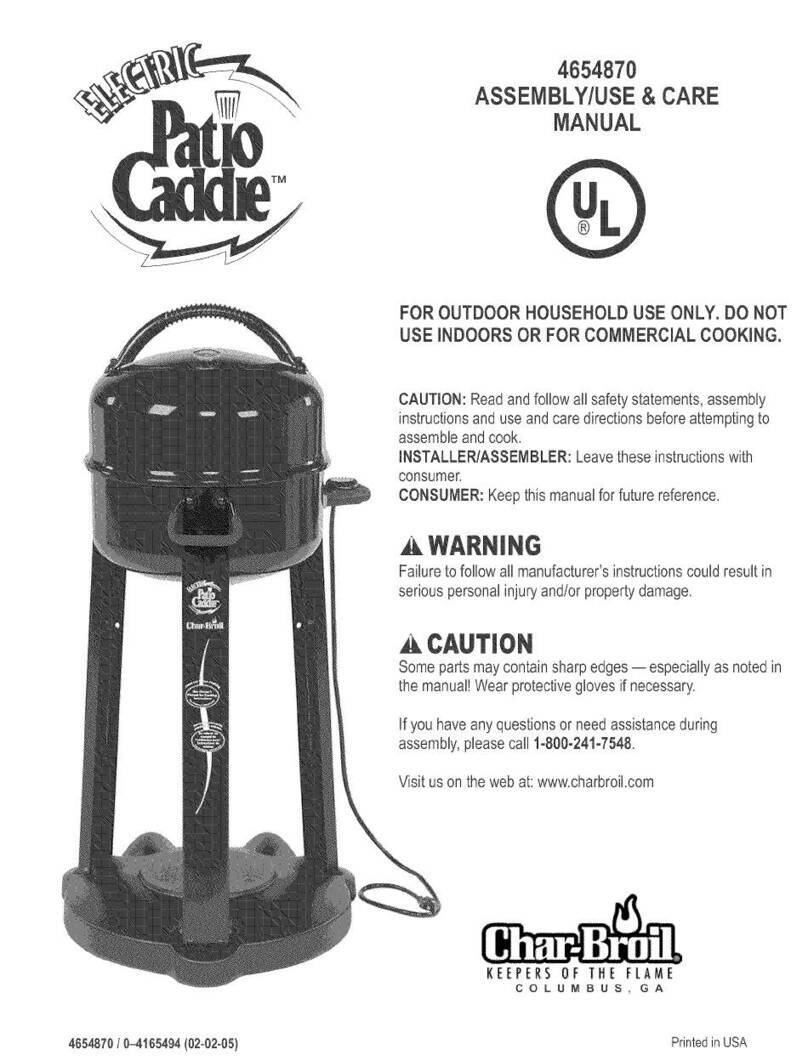
Char-Broil
Char-Broil Patio Caddie 4654870 Assembly, use & care manual
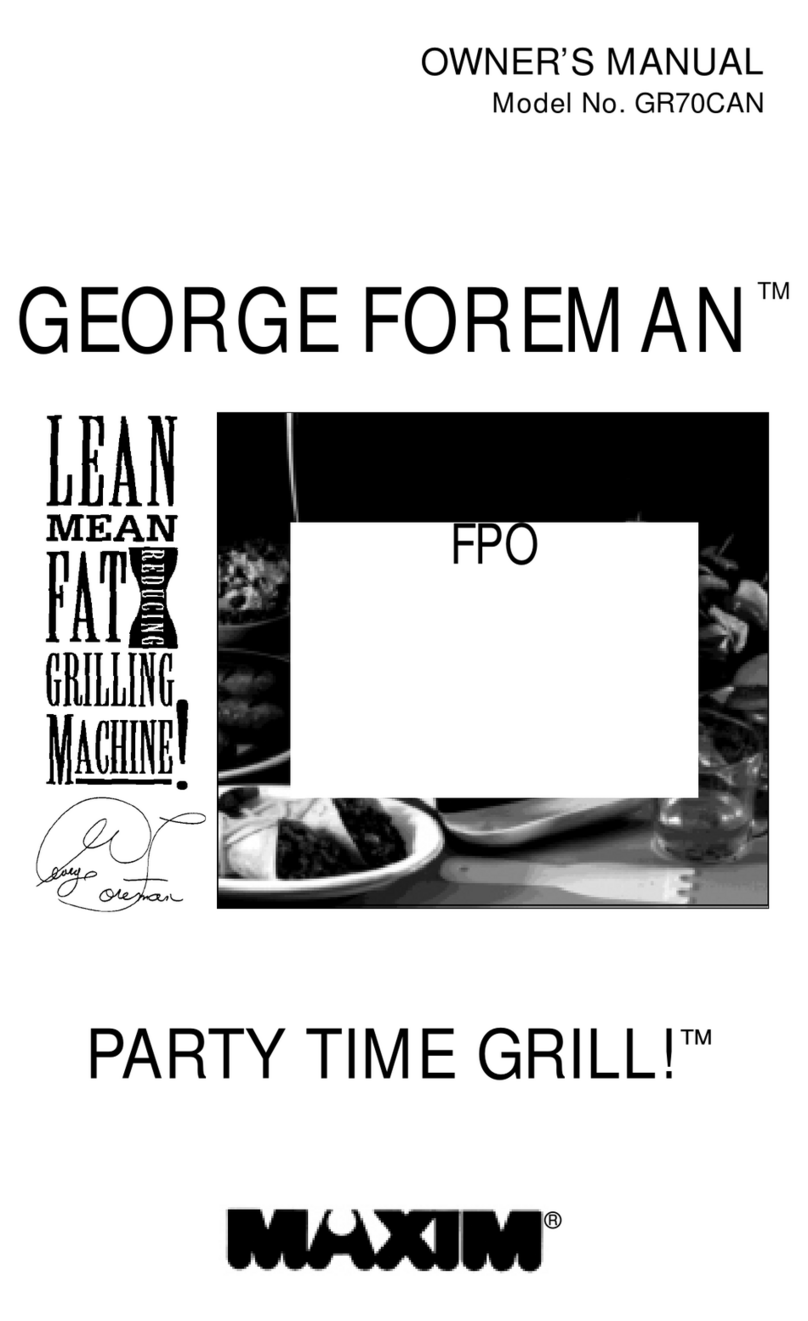
George Foreman
George Foreman GR70CAN owner's manual
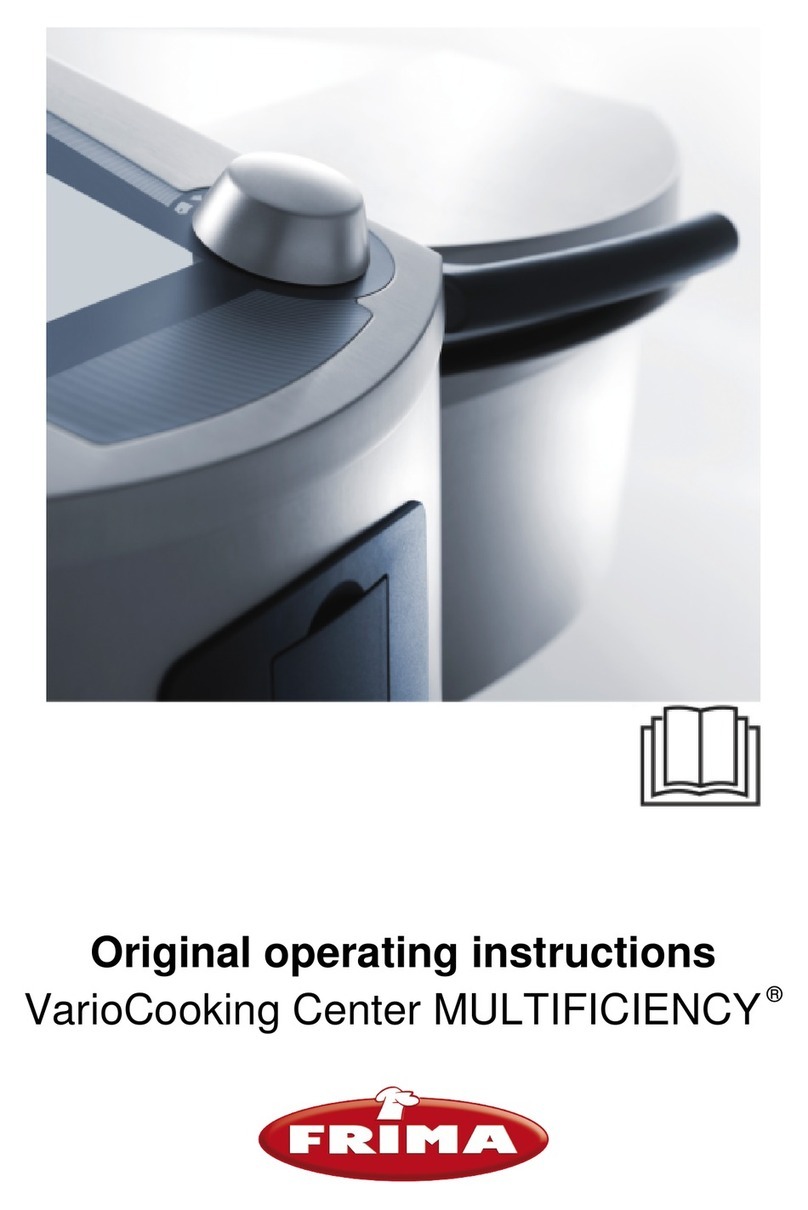
Frima
Frima VarioCooking Center MULTIFICIENCY Original operating instructions

LMS
LMS BBQ08873P owner's manual

Gaggenau
Gaggenau VR 414 610 use and care manual

Even Embers
Even Embers GAS1466AS owner's manual
